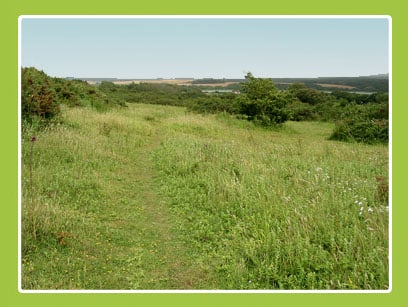GOLDEN HILL PARK
Where is Golden Hill Park?
Golden Hill Park is just south of the A3054, between Yarmouth and Colwell. It is 20 hectares in extent and surrounds the privately owned Golden Hill Fort. Footpaths F14, F15 and F70 cross the site.
When can I visit?
Golden Hill Park is always open for walkers. There is a public car park adjacent to the entrance to the fort. After years of deterioration, the Fort buildings are being developed into accommodation units by a private company. Visitors are requested to bear this in mind when visiting the site, as construction traffic associated with the development will be in the vicinity.
Why is Golden Hill so special?
The fort was built as part of the Palmerston defences between 1863 and 1869, as a coastal defence in the West Wight. Situated in a commanding position, the area was kept clear of vegetation to allow views out to the Solent. The name Golden Hill refers not to the spectacular golden display of gorse but to an historic landowner, Gauden.
| The soil types on which it stands are complex and support a wide range of plants, including the chalk loving yellow-wort and dwarf thistle, dyer’s greenweed, a feature of neutral soils and gorse which is associated with more acid soils. These attract a good range of butterflies. The habitats vary and there is a transition between open grassland, scrub and woodland. Bridleways and footpaths lead around the embankments with fine views of the valley of the River Yar. |  |
Management work involves selective scrub clearance to allow grassland species to flourish. Blocks of scrub are maintained, however, to give breeding habitat for birds, and red squirrels are seen in the area. Golden Hill Park is used well by local residents who appreciate the variety of wildlife and the extensive views.
Click here if you would like to find out more about getting involved with your local nature reserve.
Page last updated on: 15/12/2010





